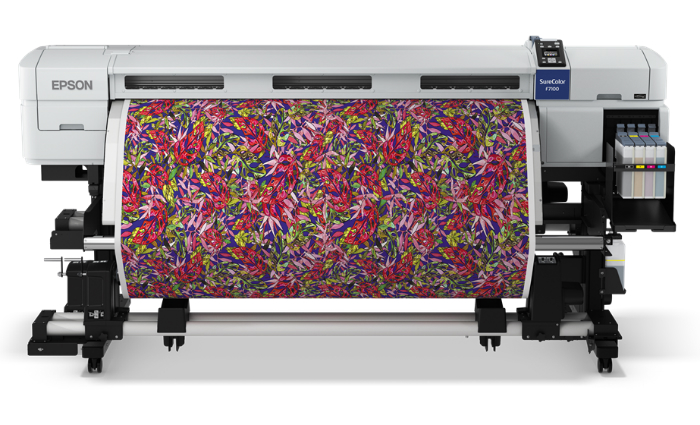
What does the printer do?
The Epson SureColor SC-F7100 is a 64in-wide (1.6m) roll-to-roll textile printer that jets water-based dye-sublimation inks from piezo-electric printheads.
When was it launched and what are the target markets?
Officially launched at Ipex last year. It is largely aimed at full-time textile producers who print complete rolls of cloth that will then be made up into garments, soft furnishings, soft signage, banners, flags and the like.
The smaller 44in (1.1m) Epson SC-F6000, which is so far the better seller, is more attractive for producing small quantities of in effect on-demand lengths to be cut to size for individual applications. Although both printers can also produce transfer paper for solid items (such as phone covers), it is likely that the F6000 would be the first choice for these.
How does it work?
Although optimised for textile transfer work with roll rewinding, it is essentially the same as Epson’s current family of SC series wide-format printers. These are progressively replacing the Stylus Pro range.
The SC-F7100 prints onto a special transfer paper, which is then brought into contact with the textile rolls in a separate heat press, normally a roller calendering machine. Epson has not so far announced any plans to run a calendering press inline with the printer. As with any dye-sub process, the end-medium needs to have a high polyester content to absorb the vapourised (sublimated) dyes.
Ink tanks are used rather than cartridges. These are 1.5 litre capacity and can be refilled on the run from resealable 1.0 litre ink pouches.
How does it differ from earlier models?
The SC-F7100 is a replacement for the SC-F7000, first introduced in April 2013. The new model adopts Epson’s latest Precision Core TFT printheads, first launched last year. These allow high resolution (720×1,440dpi) with a single row of heads. PrecisionCore self-monitors every ink chamber and nozzle, detecting and compensating for blockages on the run.
Other important improvements include a much improved take-up system that rolls the paper accurately to within +/-2.5mm on up to 40kg rolls. This is important for calendering systems where it’s key to transfer the image accurately in position. A new post-heater ensures that the ink is fully dry before going on the take-up roller, so there is no offsetting.
How productive is it?
Speed is always a knotty question with any inkjet, as it depends on how many passes you want to specify. The top speed of the SC-F7100 is 58.9sqm per hour with the lowest-quality single-pass operation, but it is 22sqm per hour for more typical three-pass working.
And in good news the nature of dye-sub transfer tends to blur out imperfections (as well as sharp detail), so more passes are not needed.
What’s the front-end?
Epson supplies the ErgoSoft rip in an Epson edition as part of the list price. This is based on the TexPrint version of its software, with special features for textile work. The lower cost F6000 comes with a Wasatch rip and there is the option of a Caldera rip.
What is its USP?
It is an all-Epson solution: hardware, printheads and ink. Other suppliers have put together dye-sublimation packages based on Epson printers for years, but this is the first with Epson’s own UltraChrome DS ink.
How easy is it to use?
The ErgoSoft rip has built-in features developed for textile work, including step-and-repeat, special colour replacement and ink limit controls.
What training and support is offered?
Epson recommends basic print training for new wide-format operators. Experienced operators only need a quick overview.
the alternatives
MIMAKI JV300-160
Mimaki got into the textile sector a good while earlier than Epson. The latest 1.3m and 1.6m JV300 (which is eco-solvent as standard) is said to be producing good results at its higher speeds when run with dye-sub inks, thanks in part to twin printheads. The inks use blue (Bl) instead of cyan, as well as a dense black (DK), specifically for textiles.
Max roll width 1.6m
Media thickness Up to 1mm
Max throughput 105.9sqm per hour (‘super draft’ 360dpi), 32.7sqm per hour (540x720dpi 4-pass), 15.4sqm per hour (1,080x720dpi 8-pass)
Max resolution 1,440dpi
Inkset BlMYDK, light blue and light magenta
Ink capacity 440ml cartridges (2 litre bulk system optional)
Footprint 2.8×0.7m
Contact Mimaki Australia
MUTOH VALUEJET 1624W
Mutoh has dye-sub models in a range of sizes and speeds. The ValueJet 1624W is nearest on price to the Epson and uses Mutoh’s DS2 water-based inks. It has a cutting knife as standard but winders and unwinders for calendaring rollers are extra.
Max roll width 1.6m
Media thickness 0.3–2.1mm
Max throughput 39m2/hr (draft), “typical production” between 14m2/hr and 27.5m2/hr
Max resolution 1,440dpi
Inkset CMYK
Ink cartridge capacity 1 litre
Footprint 2.7×0.9m
Contact Mutoh dealers
Comment below to have your say on this story.
If you have a news story or tip-off, get in touch at editorial@sprinter.com.au.
Sign up to the Sprinter newsletter
